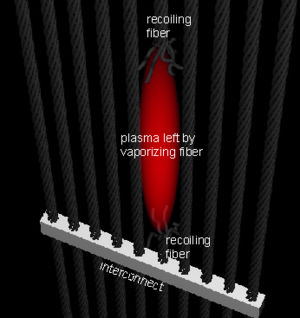RibbonEnergy
| Title: Energy Stored in the Ribbon | ||
|
[Cover Img] |
About:
|
Tags:
|
Energy Stored in the Ribbon
As a material is stretched it stores energy. In the case of the SE this energy can be released quickly when the ribbon is damaged. The question is where does the energy go? Is the CNT thread or even the ribbon vaporized or does the energy go elsewhere?
The worst case scenario is a catastrophic cascade where a single thread is damaged and as it recoils the stored energy is converted into enough heat to vaporize the thread. As the thread vaporizes it continues to recoil and vaporize until there is no thread along the length of the ribbon. In the process the recoiling thread damages neighboring threads which also vaporize. Bad scenario.

However, some of the energy will be converted to kinetic energy, some into radiative, if the threads are spun CNTs they won't act as a single unit and energy will be transferred and contraction slowed, the interconnects will slow the recoil, the threads will not recoil perfectly axially and fly out of the plane,... but we may still have issues. If so, can the ribbon be designed and run at a lower tension that eliminates the issue or do we redesign the ribbon?
Detailed material’s science and engineering are required to address this issue. A detailed computer model is likely needed as well but initial definitions can be done with little more than "paper and pencil".
The energy in a spring is
E=1/2*k*x^2
The tensile strength we can assume for a CNT thread is 100 - 200GPa and the elongation at breakage can be 10% or higher though breakage also occurs in stages where the CNT deforms or necks down releasing some of stress prior to breaking.
The vaporization temperature of CNTs in vacuum is around 6000 C but much lower in atmosphere.
If the ribbon is run at 50 GPa tension we can calculate the elongation and energy stored in the fibers. Knowing the heat capacity the temperature of the fiber can then be determined to first order.
E=V*c*T
where E is energy, V is volume, c is the heat capacity (1.5 J cm-3 K-1 for graphite) and T is the temperature change which comes out to be around 1600C depending on the choice of elongation for a given tension.
This calculation needs to be done carefully and for all possible variations first and then a more precise calculation including radiation, losses to kinetics, etc. then the heat must be dealt with.
Specific Work
- Definition paper on the physical situation including
- how things are expected to act,
- the energy transfer mechanisms. For example, direct vaporization and momentum transfer upon meteor impact.
- thermal attributes such as heat wave down thread and radiative cooling,
- mechanical aspects such as unwinding of spun threads, friction on threads pulling through interconnects, out of plane movement due to impact and simple non-uniform breaking.
- ...
- 3D Finite element analysis of a a recoiling spun CNT thread
- model the thread in detail
- model interconnects
- model stresses in the thread and interconnect and how tension transfer occurs
- Include interactions with multiple interconnects and neighboring fibers including collisions
<issues/>